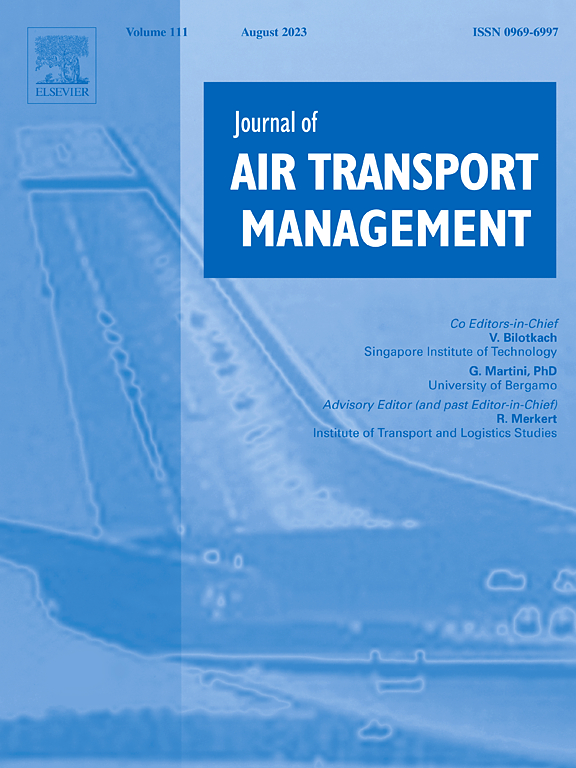航天发射失败时空中交通管制员决策中基于风险的危险走廊评估
IF 3.6
2区 工程技术
Q2 TRANSPORTATION
引用次数: 0
摘要
空间发射活动的日益频繁和多样化对当前空中交通管理系统的安全性和可靠性提出了挑战。在这项研究中,我们提出了一种基于风险的危险走廊方法,用于管理航天发射失败期间的空中交通。我们的方法结合了碎片传播模型和危险走廊构建方法,以估计碎片对飞机构成的风险。我们使用高保真人在环模拟来评估构建的基于风险的危险走廊。在我们的实验中,空中交通管制员管理两种危险走廊策略。动态危险走廊实时更新边界,而静态危险走廊在整个激活期间通过巩固动态边界保持固定,直到最后一块碎片落下。结果表明,控制员在所有场景中都保持了安全隔离,尽管他们的实时工作量在危险走廊激活期间显著增加。总体而言,控制者的感知工作量和态势感知保持稳定,这意味着任务需求在所有实验运行中都是可接受的。效率测量结果表明,动态危险走廊可以减少额外的飞行距离和延误,从而最大限度地减少因航天发射故障造成的运行中断。我们还发现,更有经验的控制员倾向于选择更谨慎和保守的改道策略。这些发现为提高航空航天管理一体化弹性提供了实践指导。此外,我们的研究为紧急情况下空中交通管制员行为的建模提供了一个更符合现实世界模式的基础。本文章由计算机程序翻译,如有差异,请以英文原文为准。
Evaluating risk-based hazard corridors in air traffic controller decisions during space launch failures
The increasing frequency and diversity of space launch activities challenge the safety and reliability of current air traffic management systems. In this study, we present a risk-based hazard corridor methodology for managing air traffic during space launch failures. Our method combines a debris propagation model with a hazard corridor construction approach that estimates the risk posed by debris to aircraft. We evaluated the constructed risk-based hazard corridors using high-fidelity human-in-the-loop simulations. In our experiments, air traffic controllers managed two strategies of hazard corridors. The dynamic hazard corridor updated the boundary in real-time while the static hazard corridor remained fixed by consolidating the dynamic boundaries over the entire activation period until the last piece of debris fell. The results show that controllers maintained safety separation across all scenarios, although their real-time workload increased significantly during hazard corridor activation. Overall, the controllers’ perceived workload and situation awareness remained stable, implying that the task demands were acceptable for all the experimental runs. Efficiency measure results indicate that the dynamic hazard corridor can reduce extra flight distance and delays, thus minimizing operational disruption caused by space launch failures. We also found that more experienced controllers tend to choose more cautious and conservative rerouting strategies. These findings offer practical guidance for improving resilience in air and space management integration. Furthermore, our study provides a basis for modeling air traffic controller behavior under emergency conditions in a way that is more in line with the real world patterns.
求助全文
通过发布文献求助,成功后即可免费获取论文全文。
去求助
来源期刊

Journal of Air Transport Management
TRANSPORTATION-
CiteScore
12.40
自引率
11.70%
发文量
97
期刊介绍:
The Journal of Air Transport Management (JATM) sets out to address, through high quality research articles and authoritative commentary, the major economic, management and policy issues facing the air transport industry today. It offers practitioners and academics an international and dynamic forum for analysis and discussion of these issues, linking research and practice and stimulating interaction between the two. The refereed papers in the journal cover all the major sectors of the industry (airlines, airports, air traffic management) as well as related areas such as tourism management and logistics. Papers are blind reviewed, normally by two referees, chosen for their specialist knowledge. The journal provides independent, original and rigorous analysis in the areas of: • Policy, regulation and law • Strategy • Operations • Marketing • Economics and finance • Sustainability
 求助内容:
求助内容: 应助结果提醒方式:
应助结果提醒方式:


